Welcome to TeardropForum.com › Forums › Teardrop Builders’ Forum › Joint between galley Flat and bulkhead failed when plywood delaminated.
- This topic has 16 replies, 8 voices, and was last updated 6 years, 3 months ago by
rlheestand.
-
AuthorPosts
-
March 12, 2018 at 2:48 pm #1704
rlheestand
ParticipantI have experienced after about 12 months (and one medium long trip) failure of the joint between the galley flat and the bulkhead. I suppose that this is due to the weight of the marine battery resting on the galley flat right behind the bulkhead and associated load experienced during trailing. I guess that I shouldn’t be surprised because the strength of the joint is dependent upon the tensile strength of the glue between the plies of the plywood (delamination occurred both within the galley flat and the bulkhead sheets). I can’t see that I missed any step in the construction that would have provided more strength to the joint. The fillet did not fail, it was the plywood.
Has anyone else experienced this?
I have added pictures of the problem below…
I have removed the galley unit and am considering how to address this. Some options below.
1. Add a 2″ width fiberglass tape strip inside the camper along the joint along the the intersection of the underside of the galley flat and the bulkhead to reinforce the joint between the galley flat and the bulkhead. Should I add two layers of the fiberglass strip here?
2. Add a 2″ width fiberglass tape strip along the joint between the intersection of the top of the galley flat and the bulkhead from within the galley space. This might require work on the galley unit to accommodate the thickness of the tape since it will be bulkier than simply adding the epoxy fillet there.
3. Both #1 and #2.
4. Any other ideas?
The advertised strength of the fiberglass tape is about 100 pounds per inch along the direction of the fibers. My hope is that it spreads the stress across a larger area at the junction of the galley flat and the bulkhead.
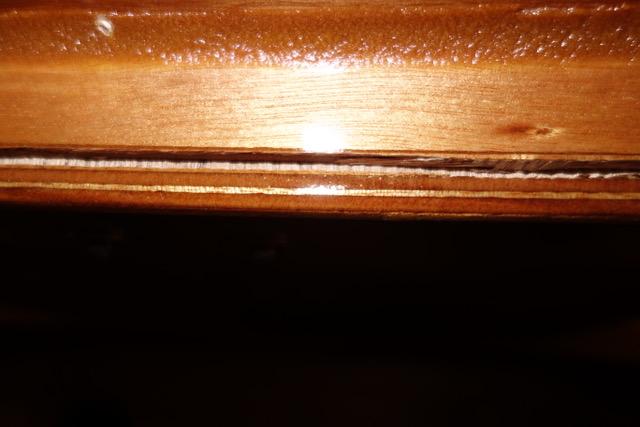
Joint failure viewed from within main cabin. Looking at the underside of the shelf at the joint between the galley flat and the bulkhead. This extends about three quarters of the distance of the joint below the shelf (complete failure of the joint).
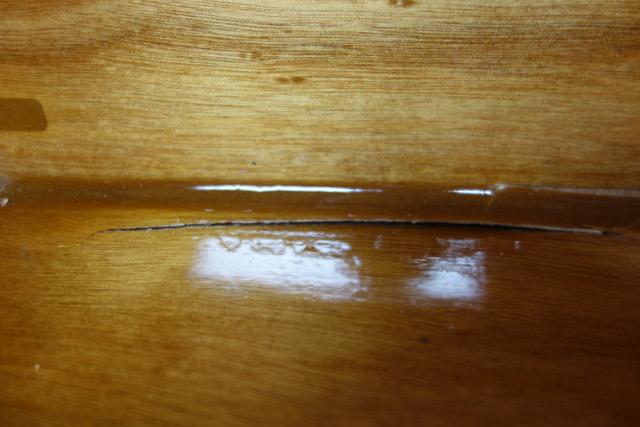
View of joint failure viewed from the galley. Shows the failure of the galley flat due to delamination of the galley flat plywood. Not that the fillet did not fail, the tensile strength of the plywood was not enough.
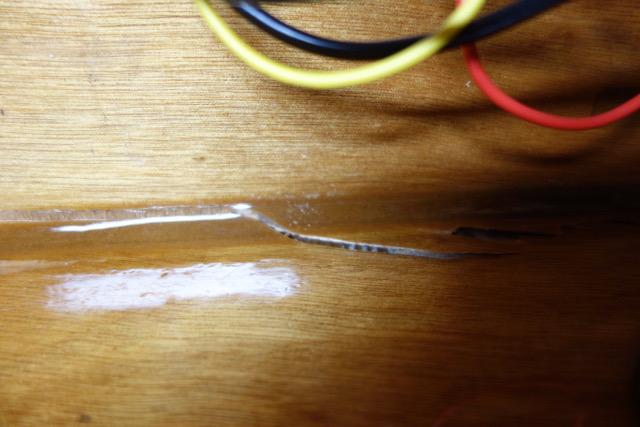
Surely it is not necessary to remove the battery when trailering to avoid this.
March 12, 2018 at 3:46 pm #1705rlheestand
ParticipantJust spoke with CLC and they were very helpful. The recommendation now is to reinforce that joint with a strip of fiberglass during building. They are supplying a 4″ strip which I will use to reinforce the joint from within the cabin.
March 13, 2018 at 10:22 am #1706abrightwell
ParticipantInteresting. As I was going through that step I was a little concerned about the level of strength the joint would have but I didn’t even consider the plywood lamination. That’s crazy. I had seen a few others that had a similar issue and it seems like in all cases it is related to the weight of the battery positioned at that point. For this reason, I made the decision that I am going to put my battery up forward in a trailer box, leaving only the cooking ‘things’ on/in the galley.
At any rate, good luck, I’d be interested to see how the repairs goes for you.
March 13, 2018 at 3:40 pm #1708ArtisticAdam
ParticipantOh no! another galley flat failure, i’m glad its not a catastrophic failure and can be patched. Out of curiosity were your battery & galley module bolted down, or could they have bounced a little? There have been others on the forum with similar issues. I made a recommendation back in august on this thread http://teardropforum.com/forums/topic/anyone-using-12v-lithium-battery/
Adding the strip of glass at this point would probably be better on the galley side not cabin side. It would be less visible and offer similar strength. You could also inject some epoxy into the failed plywood cracks and use a jack under it and some weight on top to “clamp” and press it flat while it cures.
This fix however will not prevent further damage if you mount the battery in the same location. I suggested using a bolt in battery box that hangs from the bulkhead. This mounting method will support more weight than the galley flat even with an additional glass strip. The galley flat is not designed for the concentrated weight load of AGM batteries, and I hope CLC correctly addresses this issue.
I’m not familiar with their galley module but if its not already mentioned securing the module to the bulkhead or at least the galley flat will also reduce stress on this joint. This joint can support a fair amount of STATIC weight but Dynamic loads are like a hammer… and it will fail.
March 13, 2018 at 8:01 pm #1709faithie999
ParticipantI had the identical problem on my maiden voyage, a 300 mi one-way trip to see the eclipse last august. I had not even thought about bolting my lead-acid battery down, and I paid the price.
I fortunately had a scissor jack with me along with a few short pieces of 2×4, so I was able to jack the galley flat back in place from inside the cabin for the return trip (I also removed the battery).
for the repair, I put a strip of fiberglass tape both on the “outside corner” of the joint inside the cabin, and the “inside corner” inside the galley. I have a battery hold-down arrangement in mind to try out, but since I am using my trolling motor battery I will likely spring for a lithium battery.
slightly off topic, but I helped my son outfit a sprinter for living off the grid, and on the recommendation of others who had done the same thing, we purchased a 100Ah LI battery from battlebornbatteries.com. all they make are LI batteries for off-gridders. they are roughly Group 27 size, and as has been noted by others, they can safely be discharged to almost 0% charge, so you get the full use if 100Ah, instead of discharging only to 50% with a lead-acid deep-cycle battery.
March 14, 2018 at 2:11 pm #1713rlheestand
ParticipantYes, I had secured the battery with a battery strap within a battery box. I am next going make a battery tie down strap using a ratcheting strap (constructed by cutting down a longer tie down strap from home depot) so I can feel more secure about the strap remaining tight and to make it easy to check and retighten.
I found on a fiberglass supply sight that the strength of the tape is about 100 lbs / inch in the direction of the fibers, so I suspect that that would be plenty strong enough for a strip running inside the cabin. I am also considering adding a strip in the galley (belt and suspenders).
If the problem recurs I will consider the lithium route.
March 14, 2018 at 7:42 pm #1718faithie999
ParticipantI think the strip of fiberglass tape inside the cabin (the “outside” corner of the failed joint) is more important than the inside corner, at the rear of the galley. but I would do both.
March 15, 2018 at 8:15 pm #1719friz
ParticipantI had the same failure from a 5gal flexible water jug in the galley. My battery is mounted under my camper. I think we will see more of these failures. The galley floor is not up to supporting more then light weight cargo.
March 15, 2018 at 8:23 pm #1720friz
ParticipantHere is my post from 9 months ago.
March 16, 2018 at 4:35 pm #1721rlheestand
ParticipantPrepared the galley by sanding off the varnish with 150 grit sandpaper and removing shards of plywood veneer and old epoxy fillet. In each case the epoxy had pulled the veneer off the plywood sheet. I added a new fillet (slightly broader) and immediately added a 3 inch fiberglass tape between the galley flat and the bulkhead. I am waiting for CLC to send a strip of 4 inch fiberglass tape which I will apply to the joint from within the cabin.
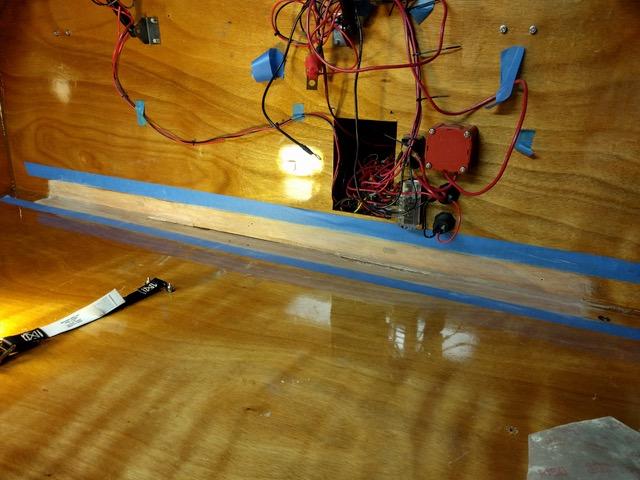
Prepared for tape
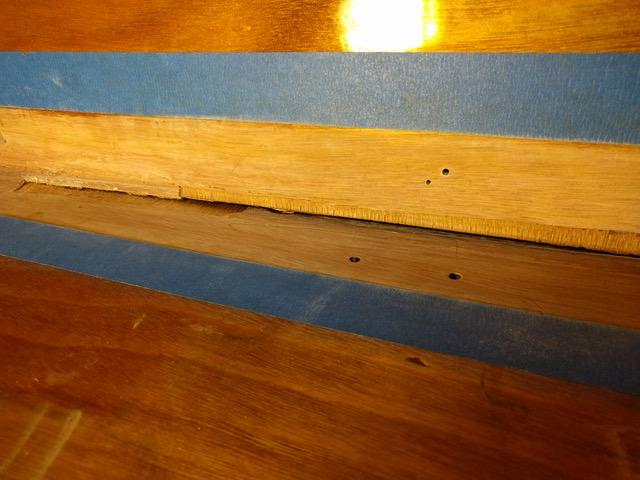
Preparation closeup
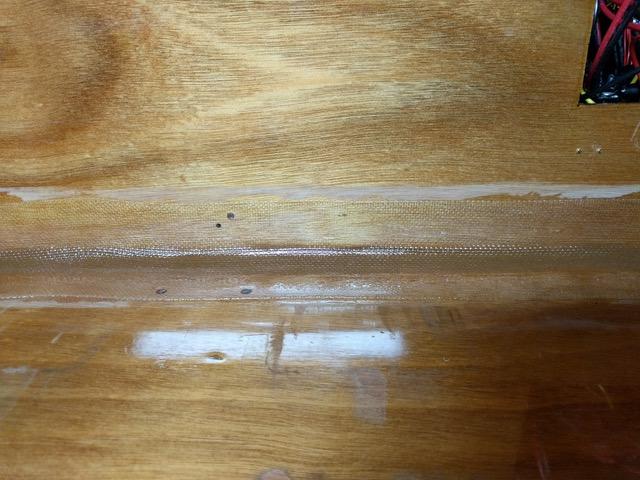
Tape added
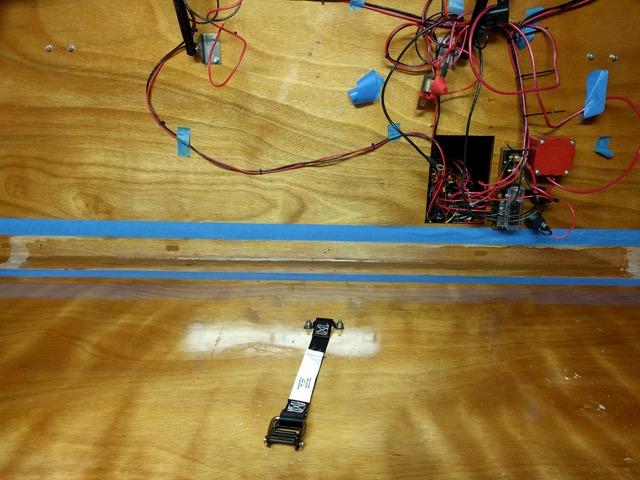
-
This reply was modified 6 years, 4 months ago by
rlheestand.
March 18, 2018 at 3:14 pm #1723western_flyer
ParticipantThe bulkhead bowed out during the curing leaving part of galley flat/bulkhead joint exposed. I faired in the gap with putty and covered it with 3 inch fiberglass tape. I’ll do the same when I can access the galley. That should hold it.
No pics. The TD is closed up tight right now
March 23, 2018 at 8:19 am #1725caveprod
Participant
I have been worrying about this aspect for a few months now, and this is what I intend to do. Fibreglass tap along the seam, maybe along the bottom too, it might not look great, but it should be pretty hidden too.
The marine ply boards are 9 and 18 mills thick respectively will be fiberglassed with matt to the bulkhead and the flat. The aluminium bracket will be screwed with maybe six/eight or more wood screws to the bulkhead and flat, the idea being that the load will be supported by the bulkhead as much as anything. I had thought about putting the lead crystal battery on the frame of the trailer, but then it is pretty inaccessible.
I hope my photo came out…
-
This reply was modified 6 years, 4 months ago by
caveprod.
March 29, 2018 at 11:30 pm #1733mx5tc
ParticipantFWIW, I think the issue is the dubious placement of a heavy marine deep cycle battery in the weakest spot of the camper shell structure. The battery weighs more than other component in the camper shell structure and is simply going to stress the galley flat/bulkhead joint too much. Additionally, it is also relatively high up in the structure and raises the center of gravity too much. An AGM battery can be mounted sideways on the trailer structure right in front of the axle which lowers the center of gravity and avoids putting stress on the galley flat/bulkhead joint. “Fritz” (sp?) on this site mounted his battery that way and provided some pictures of his installation. I just received my CLC kit this week and am still finishing up my parts inventory but I will definitely not be putting a heavy marine battery in the CLC galley location. Every pop up camper made in the last 40 years has mounted the marine battery(s) either on the trailer tongue or in the very front on the camper box (on the floor) for proper CG and trailer weight and balance purposes. The CLC design simplifies wiring at the expense of raising CG and stressing the galley flat. YMMV,
Mitch
April 6, 2018 at 6:24 am #1751faithie999
Participantfriz–i ordered an AGM battery and will mount it under the camper. could you pls point me to the thread where you have pictures of your mounting arrangement? also, did you find any kind of nifty weathertight fitting for passing the battery wiring through the floor?
thanks
ken
April 6, 2018 at 10:01 am #1752ArtisticAdam
ParticipantFathie, I believe this is the thread you are referring to http://teardropforum.com/forums/topic/alternative-simple-electrical-system/
For the cable pass through you could get 2x simple water tight cable glands like this:
Or one designed for solar panel connections:
-
This reply was modified 6 years, 4 months ago by
-
AuthorPosts
- You must be logged in to reply to this topic.